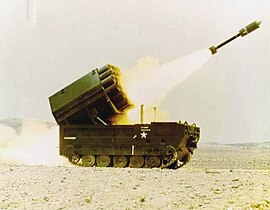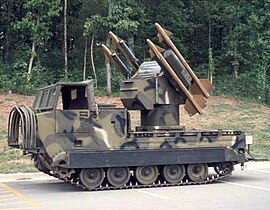
Rapier is a surface-to-air missile developed for the British Army to replace their towed Bofors 40/L70 anti-aircraft guns. The system is unusual as it uses a manual optical guidance system, sending guidance commands to the missile in flight over a radio link. This results in a high level of accuracy, therefore a large warhead is not required.
This is a list of aviation-related events from 1984.

The 9M133 Kornet is a Russian man-portable anti-tank guided missile (ATGM) intended for use against main battle tanks. It was first introduced into service with the Russian army in 1998.

The M24 Chaffee was an American light tank used during the later part of World War II; it was also used in post–World War II conflicts including the Korean War, and by the French in the War in Algeria and the First Indochina War. In British service it was given the service name Chaffee after the United States Army General Adna R. Chaffee Jr., who helped develop the use of tanks in the United States armed forces. Although the M41 Walker Bulldog was developed as a replacement, M24s were not mostly removed from U.S. and NATO armies until the 1960s and remained in service with some Third World countries.

The M113 is a fully tracked armored personnel carrier (APC) that was developed and produced by the FMC Corporation. The M113 was sent to United States Army Europe in 1961 to replace the mechanized infantry's M59 APCs. The M113 was first used in combat in April 1962 after the United States provided the South Vietnamese army (ARVN) with heavy weaponry such as the M113, under the Military Assistance Command, Vietnam (MACV) program. Eventually, the M113 was the most widely used armored vehicle of the U.S. Army in the Vietnam War and was used to break through heavy thickets in the midst of the jungle to attack and overrun enemy positions. It was largely known as an "APC" or an "ACAV" by the allied forces.
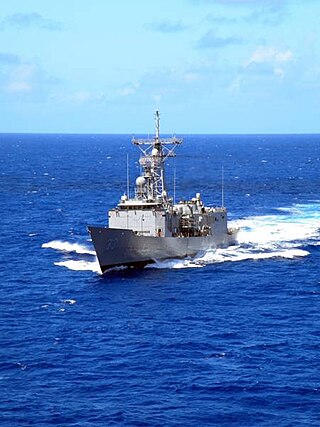
USS Jarrett (FFG-33), was the twenty-fifth ship of the Oliver Hazard Perry-class guided missile frigates, was named for Vice Admiral Harry B. Jarrett (1898–1974).
The 9K34 Strela-3 is a man-portable air defense missile system (MANPADS) developed in the Soviet Union as a response to the poor performance of the earlier 9K32 Strela-2 system. The missile was largely based on the earlier Strela 2, and thus development proceeded rapidly. The new weapon was accepted into service in the Soviet Army in January 1974.

The ZSU-57-2 Ob'yekt 500 is a Soviet self-propelled anti-aircraft gun (SPAAG), armed with two 57 mm autocannons. 'ZSU' stands for Zenitnaya Samokhodnaya Ustanovka, meaning "anti-aircraft self-propelled mount", '57' stands for the bore of the armament in millimetres and '2' stands for the number of gun barrels. It was the first Soviet mass-produced tracked SPAAG. In the USSR, it had the unofficial nickname Sparka, meaning "twin mount," referring to the twin autocannon with which the vehicle is armed.

The Raytheon MIM-23 HAWK is an American medium-range surface-to-air missile. It was designed to be a much more mobile counterpart to the MIM-14 Nike Hercules, trading off range and altitude capability for a much smaller size and weight. Its low-level performance was greatly improved over Nike through the adoption of new radars and a continuous wave semi-active radar homing guidance system. It entered service with the US Army in 1959.
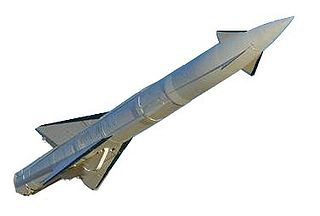
The Roland is a Franco-German mobile short-range surface-to-air missile (SAM) system. The Roland was also purchased by the U.S. Army as one of very few foreign SAM systems.

The M107 175 mm (6.9 in) self-propelled gun was used by the U.S. Army and U.S. Marine Corps from the early 1960s to the late 1970s. It was part of a family of self-propelled artillery that included the M110. It was intended to provide long-range fire support in an air-transportable system. It was exported to several other countries including Germany, South Korea, Spain, Greece, Iran, Israel, Italy, the Netherlands, the United Kingdom, and Turkey. The M107's combat history in U.S. service was limited to the Vietnam War; it also saw extensive combat use in Israeli service. The M107 shared many components with, and in many cases was replaced by, later versions of the M110 203 mm (8.0 in) howitzer. Although withdrawn from U.S. service in the late 1970s, it continues to see military service as of 2024.

The Family of Medium Tactical Vehicles (FMTV) are a series of military vehicles based upon a common chassis, varying by payload and mission requirements. The FMTV is derived from the Austrian Steyr 12M18 truck, but substantially modified to meet United States Army requirements. These include a minimum 50 percent U.S. content.

The AIFV is a US tracked light armored vehicle that serves as an infantry fighting vehicle (IFV) in the armies of several countries. It is a development of the M113A1 armored personnel carrier.

The BTR-4 "Bucephalus" is an amphibious 8×8 wheeled infantry fighting vehicle (IFV) designed in Ukraine by the Kharkiv Morozov Machine Building Design Bureau.
A huge number of M113 Armored Personnel Carrier variants have been created, ranging from infantry carriers to nuclear missile carriers. The M113 armored personnel carrier has become one of the most prolific armored vehicles of the second half of the 20th century, and continues to serve with armies around the world in many roles.

The M901 ITV is an American armored vehicle introduced into service in 1979, and designed to carry a dual M220 TOW launcher. It is based on the M113 Armored Personnel Carrier chassis. The M901 ITV is no longer in service with the United States Army, its primary user.

On 29 November 1990, the adoption of United Nations Security Council Resolution 678 authorized the assembly of a multinational military coalition to fight against Iraq in the Gulf War. The coalition's purpose was to liberate Iraqi-occupied Kuwait by "all necessary means" if Iraq did not withdraw by 15 January 1991. Iraq failed to relinquish control over Kuwait by the deadline specified in Resolution 678, leading to the commencement of combat operations with the Gulf War aerial bombardment campaign on 17 January 1991. At this time, the coalition consisted of 42 countries and was spearheaded by the United States: the central command was led by the United States, Saudi Arabia, and the United Kingdom; the marine command was led by the United States; the Joint Forces East Command was led by Egypt, Saudi Arabia, Syria, Morocco, Kuwait, Oman, the United Arab Emirates, Qatar, Bahrain, Poland, and Czechoslovakia; and the Joint Forces North Command was led by the United States, the United Kingdom, France, Canada, Italy, Australia, Japan, and Turkey. On 23 February 1991, the aerial bombardment campaign came to an end as the coalition began a large-scale ground offensive into Iraqi-occupied Kuwait and parts of Iraq. The Iraqi military was devastated in the fighting, and Kuwait was declared completely free of occupying Iraqi troops on 28 February 1991.

The MAN Category 1 is a family of high-mobility off-road trucks developed by MAN SE for the German army. Production continued through an evolution of the design with the final iteration (SX) in production until early 2019.
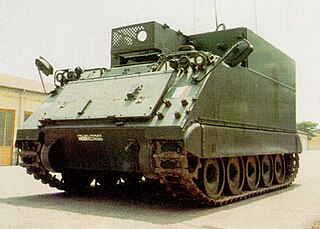
The M577 Command Post Carrier, also known as the M577 Command Post Vehicle or Armored Command Post Vehicle, is a variant of the M113 armored personnel carrier that was developed and produced by the Food Machinery and Chemical Corporation (FMC) to function on the battlefield as a mobile command post i.e. a tactical operations centre, usually at the battalion level. In U.S. military service its official designation is Carrier, Command Post, Light Tracked M577.





